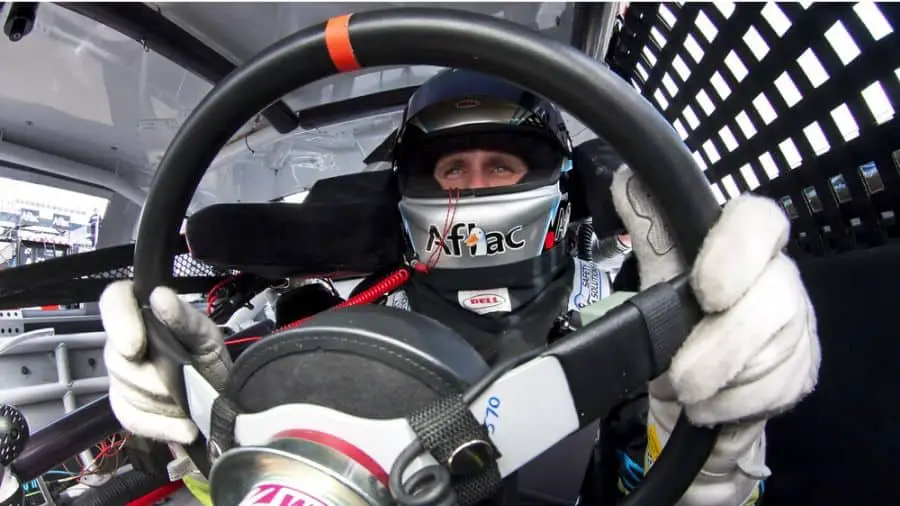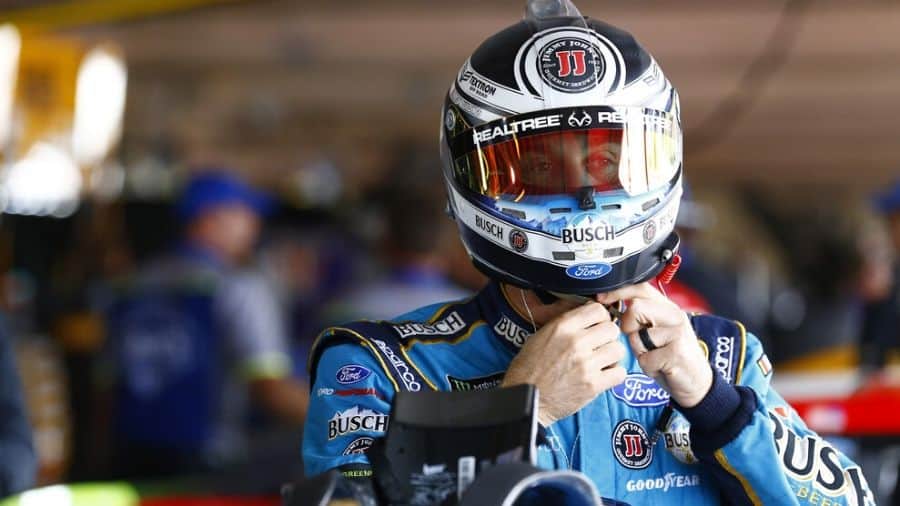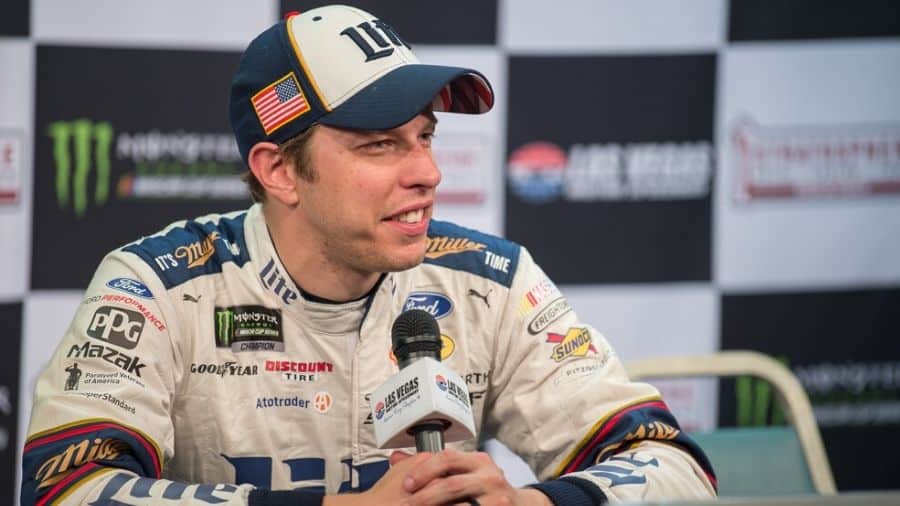
If you thought that NASCAR drivers only turn left, drive in circles and that their race cars are all the same to make their sport easier, then you’re very much mistaken. The 42 drivers in the NASCAR Cup Series are professional athletes who are at the pinnacle of their sporting careers – then you might be wondering what makes a good NASCAR driver? We’ve investigated this and you’ll be amazed by the answers!
What makes a good NASCAR driver is more complex than simply being the fastest; it is the combination of skills and experience gained through years of motorsport competition: mental fortitude, physical endurance and strength, marketability, business perception, technical aptitude, bravery, fast reflexes, confidence and a burning ambition.
NASCAR drivers are as highly skilled as other professional athletes in other sports, with these race drivers requiring enormous amounts of mental and physical skill to be successful. Take a deep dive with us as we delve into the 9 traits that make a good NASCAR driver reach the top step in this demanding sport.
Table of Contents
1. Physical Endurance
The most demanding part of being a NASCAR driver is the physical toll it takes on race drivers. From the first lap of their first race to the very last corner of the last lap of the final race of the season, a good NASCAR driver needs to be in total control of their 750 hp race cars.
A race is typically 3-4-hours long and covers 400-600 miles, while a race season lasts for 10 months and stretches over 38 races. Physical endurance is a must-have trait for a good NASCAR driver to succeed.
What is physical endurance? It is the ability of a person to withstand an exhausting activity with the least amount of fatigue at the end.
When a NASCAR driver’s physical endurance is low – due to fitness or injury – their race pace is undoubtedly affected. A NASCAR car is a hot office to be sat in for 3-4 hours while racing. Temperatures inside the car push past 125 degrees Fahrenheit and sap the energy of a driver – and lead them to lose more than 10 lbs through sweat alone during each race.
That physical stamina required to keep racing a car inch-perfect around a track for 300 or more race laps is crucial not only for the driver to reach the race’s finish but to avoid crashing.
At 200 mph, if a race driver has to fight to concentrate and to think clearly for even a second, to be able to absorb all the information and to react to a situation in a split-second, there is no room for error. It is towards the end of the races that the crunch time really hits and that the race demands their ultimate concentration, focus and energy. That is when those last race-winning plans can be created and executed over your weary rivals.
Through strenuous daily cardio and strength exercises with the help of personal trainers, NASCAR drivers are able to improve their physical endurance to cut the effects of exhaustion in the race car.
2. Physical Strength
Painful necks, burning arm muscles and breathless: that is what a normal person would feel after just a few laps around a NASCAR track at 200 mph. These race cars and their race tracks demand high levels of physical strength from race drivers.
When a NASCAR laps a race track, the turns combined with the speed they are taken at generate gravitational forces that weigh down drivers’ arms and necks.
Going through a turn at speeds of 160 mph and faster, a NASCAR driver is subjected to 3 Gs to 4 Gs of gravitational force – meaning that their arms and neck weigh 3-4 times their normal weight and place a heavy strain on their upper body.
In fact, NASA astronauts only experience 3 Gs of gravitational force when their rockets take off. To put a NASCAR driver’s ordeal into perspective, an average person’s head weighs around 11 lbs so when a NASCAR is racing through one of the turns their head weighs 33 lbs.
If that was just once or twice in a race, that would be okay. However, there is no letting up of these G-forces as NASCAR cars compete for 300 or more laps each race to put their drivers under severe physical strain.
To counteract the heavy effects of those energy-sapping G-forces and to better cope with the relentless pounding on their arms and necks for 3-4 hours every race, drivers build their upper body strength through weight training and specific exercises for their necks, shoulders and arms.
Without that upper body strength, no race driver would be able to finish a race let alone maintain high speeds and push other drivers to race for position. That is why NASCAR drivers are some of the fittest athletes in professional sport: to better endure the punishing hours of intensity in their race cars.
3. Fast Reflexes
Lightning fast reflexes can save a NASCAR driver from hitting a concrete wall or help them set the fastest lap time in a race.
Race car drivers become so in tune with their racing cars that they are able to feel every bump and crack on a NASCAR track, feel the differences in how each of their car’s tires holds up around a track’s different turns, and how their car slides when they apply full throttle.
There is no natural physical trait that a good NASCAR driver was born with that makes them faster than other drivers. Over thousands and thousands of laps around race tracks, a good NASCAR driver is able to hone this special connection between race driver and car to develop faster reflexes.
Fast reaction times help drivers avoid crashes while also helping them to adjust their car’s speed and steering quicker in response to changing conditions. That helps a good NASCAR driver to push harder for an even faster lap time. As we’ve already revealed, faster reaction times develop only with practice, repetition and thousands of laps.
Hand-eye coordination and depth perception skills play a large role in improving reflexes. As with any professional athlete, starting with the basics is important.
For a NASCAR driver, that is usually go-kart racing or midget racing. This grassroots start teaches the fundamentals of hand-eye coordination and depth perception skills for racing, and as the driver progresses up the motor sport ladder and racing speeds rise, these skills play a larger role.
Knowing exactly where their car’s gear lever is without needing to take their eyes off the track or off the car ahead of them, knowing when they need to use the brake pedal to scrub off speed to avoid bumping into another car isn’t a trait that any driver is born with.
These hand-eye coordination and depth perception skills create faster reflex actions and responses, enabling a good NASCAR driver to accurately judge where exactly in a turn their car should best be positioned for maximum speed, where their rivals are spaced around them in a turn, and how deep they can go into a turn before needing to use the brakes.
A product of faster reflexes is what professional athletes across many sports call “intuition.” NASCAR race drivers also refer to it as “feeling.”
You’ll hear a NASCAR driver commenting in interviews after races that they “drive by the seat of their pants” to win. This intuition enables a driver to instinctively respond and react to the car’s movements with fast adjustments.
This helps a good NASCAR driver to prevent their car from stepping out of line or to catch their car before it spins if another driver tapped them from behind.

4. Racer’s Instinct
The “racer’s edge” or the “racer’s instinct” is sometimes the most difficult trait to quantify for a racing driver, but it is the most easily identifiable characteristic.
To be the fastest in a sport where marginal gains are measured in 0.001 of a second, NASCAR drivers are required to have an unshakeable ambition.
For instance, with two racing drivers with equal experience, equal machinery and on the same track, one will find a way to edge that 0.001 of a second’s advantage over the other. In a race, that could be the difference between a race win or second place.
In motor sport this ambition is formed through that “instinct”, in knowing when and how to eke out something extra special to pull off that winning move.
It happens most often when a racing driver follows their rival for nearly the entire race distance to then pull out from behind them to race ahead in the very last moment. That takes years and years to hone. In fact, you either have it or you don’t. Only the really good NASCAR drivers have it.
5. Experience
A trait never to underestimate is experience. A good NASCAR driver is more often an experienced race driver, one who has paid their dues in the lower leagues and worked their way up the ladder to reach the top tier.
There are no shortcuts to success in professional sports, and in NASCAR that holds especially true.
Years competing in motor sport, on different tracks, and over countless number of laps: those all combine to make for a more rounded racing driver with untold knowledge and insider tricks to gain more speed.
A good NASCAR driver is able to “read” a race through this knowledge, and make adjustments to their speed, their pit stops, their racing line, or race strategy to overcome their rivals to take victory.
Experience is when a driver has a deeper understanding of their race car and the wheel-to-wheel racing, that edge to get them to the finish line first.
As with many professional racing drivers, this experience started when they took to their first motor sport race when they were youngsters competing in go-karting or midget racing and their knowledge won’t stop accumulating until their very last race is over.
A race driver’s experience is their ability to pinpoint where their car’s strengths and weaknesses might be, but most importantly it is knowing how to improve it and adjust their driving style to turn that weakness into a strength.
6. Technical Aptitude
A good NASCAR driver has a deep understanding of the mechanics of racing cars. In fact, this is a must-trait as a professional race driver.
A race driver doesn’t need to know every single design aspect of a certain type of engine component, but to have a deep knowledge of the various aspects will make for a better driver.
How could having a technical aptitude help a driver in racing when a team of mechanics look after a race car?
As motor sport advances in technology, so do the racing cars. However, a good NASCAR driver is an invaluable link between the crew chief and the car.
The crew chief – who is responsible for carrying out any work on a race car and overseeing its performance – relies on the feedback of race drivers to improve their car’s performance.
Computer systems and diagnostic machines help the engineers to dial in aspects such as suspension settings to improve the handling through turns, but a good NASCAR driver is able to provide deeper information on how the car feels and where the weaknesses are in the car’s overall settings where more speed can be unlocked.
Understanding of the car’s various systems and components will also allow a good NASCAR driver to adapt their driving style to better suit the car’s optimum handling.
On the other hand, when things go awry in the race car, the driver will be able to judge the situation without needing to make a very long pit stop to diagnose the problem and then repair it.
For instance, if the driver knows precisely what a problem is, they can then adapt their pace and driving to compensate for that problem and continue to race to score valuable championship points.
7. A Sharp Mind

When you’re tired, your brain begins to play tricks on you. Your thought processes slow down, your brain is less responsive and is slower in solving problems and reacting to situations.
Now, imagine when you’re hurtling around a race track at speeds over 180 mph for the past 3-4 hours. You’re bound to be mentally drained and your thinking is somewhat unclear. That is when mistakes happen and crashes occur in NASCAR races.
To stay focused for 3-4-hour long races, a good NASCAR driver must have high levels of mental acuity – a “sharp mind.”
Every lap is crucial. Every second is important. One lapse in concentration can result in a crash, after all.
A good NASCAR driver absorbs a wide array of information coming at them on the radio, from the pit lane, from their crew chief, and their spotter (a team member who provides them with information on their rivals’ track position and of any crashes ahead of them on the track).
The driver is continually being updated with information relating to:
- The changing condition of the track
- The many different race situations playing out all around them on the track
- Weaknesses in their rivals’ speed to leapfrog them on the track
This mental capacity and ability to process and utilize information can be the difference between a race win and a 20th place finish in a race.
The mental demands of competing in NASCAR are huge for drivers. Fortunately for the race drivers, developing a sharper mind – just like with other skills in professional sport and other forms of motorsport – can be achieved over many years of racing experience.
When a person starts out participating in motorsport at the grassroots level, they learn to absorb information from their go-kart or midget on how it feels and handles, the changing race track conditions, and other areas such as weather, to allow them to drive faster.
Naturally, progressing up the ladder of speed in motorsport multiplies that influx of information to near-overwhelming levels for non-racing drivers like you and me.
Don’t forget that every race driver develops these complex concentration skills over many years. Processing all that information quickly, to absorb it while they’re screaming around a race track at speeds over 180 mph, enables a racing driver to compete at the highest levels.
Like with every bit of information that comes at racing drivers when they’re on the race track, a good NASCAR driver is able to retain that info to pass it onto their race engineers and crew chiefs after the race.
These discussions are called “debriefs” and when the team analyses the data along with the information from the race drivers, they are able to better understand how and where they can fine-tune their race cars for more speed at the next race.
The benefit of this improved mental capacity and a sharper mind is that it reduces stress in tense situations in the race car.
Just as with jet fighter pilots, keeping a cool head in tense moments allows them to think clearer and maintain their fast reaction times.
For instance, if a driver’s car picks up a puncture and the driver is still driving at high speeds, the driver will need to quickly react to the situation to safely move their car off the racing line and away from the charging cars coming from behind – while still driving as fast as possible to reduce the loss of time and track position.
If a driver is overcome with panic and overwhelmed by the amount of information to process, it might result in them making a mistake such as spinning their car or slamming into the concrete walls around the track.
8. Professionalism in Business

You might have read that heading and wondered what professionalism in business and driving a race car have to do with each other. However, this is a critical component of what makes up a good NASCAR driver.
The top tier of any professional sport is surrounded by big businesses and lots of money.
Drivers need to be able to market themselves to the public and sponsors as best they can to remain in the sport’s spotlight. NASCAR is a multi-million dollar business with some of the world’s biggest brands and companies involved – and it is a cut-throat environment with hundreds of drivers waiting for an opportunity to race in NASCAR.
Long gone are the days of NASCARs humble origins of bootleggers racing each other on beaches in the 1940s; today NASCAR drivers aren’t simply race car drivers: they’re also brand ambassadors and spokespeople for their teams and sponsors as well as being role models and need to behave in a professional manner at all times.
Attracting and keeping sponsors happy is one of the functions a good NASCAR driver has for his team.
Simply put, without sponsors a team would be unable to compete. An average NASCAR team needs about $15 million each season and each team employs around 100 staff members to prepare, develop and maintain their race cars.
What sponsors require in return is strong marketing and advertising of their brand and products. In a world increasingly leaning towards social media, and the celebrity of people in the media, NASCAR drivers are in the spotlight on- and off-the-track.
A good NASCAR driver is seen to endorse their sponsor’s products, appear in commercials and advertisements, speak at sponsor’s events and media conferences, arrange and feature at fan interaction sessions and be active on social media and in the media to continually generate hype for their sponsors’ money, as well as representing their sponsors in a positive light.
To underline the importance of professionalism in business for NASCAR drivers, there have been instances where sponsors have distanced themselves (and ceased sponsorship and funding) from teams and drivers for unsportsmanlike actions, hate speech, media scandals or misrepresenting their sponsor’s image. The financial implications of this are not to be understated.
On the other side of professionalism in business for racing drivers, is the importance of establishing and nurturing business relationships and networking.
When starting out in the lower rungs of motorsport, a good NASCAR driver has already established their reputation with their sponsors in previous seasons and different motorsports. Networking, in this way, is a vital part of a good NASCAR driver’s skill set.
NASCAR drivers are always well presented and represented at race meetings and away from race tracks. A good NASCAR driver is always selling themselves to potential sponsors and team owners.
The motorsport community, while global, is small in terms of professional race car drivers. Transitioning from amateur to professional race driver is a dream only a few drivers can realize.
A seasoned NASCAR driver with a fantastic networking and professional business outlook will usually find themselves continuing their motorsport and NASCAR careers as team owners and team managers once they have retired as racing drivers. Every aspect of a team must be understood to better empower the racing driver.
9. Team Player
To be successful in NASCAR isn’t only about being the fastest driver. With this article, we’ve already shared what it takes to be a NASCAR driver, but this one final trait is what will make for a successful career in NASCAR.
Being a team player is equally as important as technical aptitude, physical endurance or race experience.
A NASCAR team comprises of a staff of more than 100 members, and while the race driver is constantly in the media’s focus and the object of fans’ cheers, relying on a team and playing a function in a team is more important.
Why if a racing driver is alone in the race car is being a team player important?
Because, the driver is the connection between the race car and the team.
Working as a team, alongside the crew chief, the various engineers, mechanics and pit crew, the race driver is able to relay critical information to them to help fine-tune the race car.
A NASCAR race weekend typically begins on a Thursday, with races starting on a Sunday. Over the course of the three days, a driver is only allowed four one-hour-long practice sessions and 1 qualifying lap before the start of the race on Sunday afternoon.
In between that on-track time, the driver is usually in meetings with his team’s crew chief, engineers and mechanics looking for ways to improve the car’s speed and handling for the race.
Every interaction between the driver and his engineers is a learning session for both to figure out different strategies to unlocking more potential speed.
Apart from the Driver’s championship – which receives the most focus from fans and the media – are the equally important Team Owner and Manufacturer championships.
Every point scored helps the team to success and with success comes the potential for an increase in sponsorship earnings. That in turn will boost the team’s fortunes for the following season – and enable the driver to go even faster.
